

For this reason, vent-free systems are up to 99% efficient! This allows them to be placed pretty much anywhere within a home except bedrooms and bathrooms. Since there is no venting, all of the warmth generated from the fire stays in the room where it is installed. Vent-free hearth products can be installed without venting up a chimney or to the exterior of the house. Vent-FreeĪccording to Fireplaces Now, 45 million homes worldwide and more than 8 million American homes enjoy the comfort and convenience of vent-free gas fireplaces. They do produce the most attractive flame pattern and have flexibility with vent pipe runs. However, even though they may be less expensive to install, they are more sensitive to air flow inside the home. Some Natural vent hearth products can be as little as 20% efficient, making them the least efficient units available. Some Natural vent hearth products have a sensor to extinguish the fire in case exhaust gasses ever reverse and come down the flue. Natural vent (also referred to as B-vent) hearth products take in combustion air from inside the home and vent products of combustion outside home via a brick and mortar chimney or pipe venting system installed through the roof. Direct-vent fireplaces are best for newer, more air tight homes. They can be installed almost anywhere! From a heating standpoint, a direct-vent fireplace will be around 70%-85% efficient. In terms of versatility, you can vent a direct-vent fireplace horizontally or through the roof. In fact, 90% of gas fireplaces are sold direct-vent because of their increased safety, efficiency, and versatility (Source: Build with Propane). Most homeowners who choose direct-vent models enjoy the peace of mind of knowing that all odors and pollutants are being vented outside of their home and not in the air they breathe.ĭirect vent fireplaces are the most popular choice for homeowners. These fireplaces will typically have a sealed pane of glass on the front of the fireplace.

Direct-vent systems transfer the combustion fumes and pollutants outside the home via a chimney or an opening on the exterior of the home. If you are in the market to buy a gas fireplace, you’ll want to consider the pros and cons of these four available venting options: Direct-Ventĭirect-vent hearth products are the safest option for supplemental heating. Combine the flexibility of installation with improved efficiency and a vast array of styles, and you’ll see why gas fireplaces are one of the hottest hearth products on the market today. With recent advancements in gas fireplaces, homeowners have plenty of unique and affordable options to choose from. Fireplaces are one of the top amenities homeowners are looking to buy for their home.


 0 kommentar(er)
0 kommentar(er)
